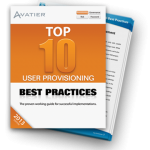With scores of folks navigating your networks, is your IT department keeping a handle on who’s accessing proprietary data? There are so many user groups needing just a small sliver of access — employees, channel partners, contractors, vendors, customers and prospects — it’s virtually impossible to keep it all straight on a granular level. How do you most effectively manage enterprise user provisioning? Integration is the answer.
When you’re managing information security for a large, multi-national organization with thousands of users with millions of moving parts at play, preserving the security of the data is merely the end-game. A framework that unravels the complexity of the business environment to automate access management and fulfill governance risk and compliance regulations at a reasonable price is how you get there.
Time, money, focus and perceived complexity can muddy the waters around effective access provisioning. Too many organizations muddle through with overly permissive account provisioning policies because there are just so many other “important” things competing for the front-burner position.
When you consider the information security risk associated with a junior administrative assistant accessing confidential personnel files or a contractor sifting through and downloading proprietary marketing assets, it’s certainly cause for concern — but not panic. However, consider what could happen when your star salesman jumps ship and snags your customer files on the way out the door. What if a disgruntled product engineer were to download and port the schematics for your new product release and shop it to a competitor? Even worse, what if a customer service representative were to poke around in customer account records and swipe and sell personal financial data?
For organizations of significant scale, these IT risks can and will eventually materialize. With thousands of users, there will inevitably be some bad apples and a whole lot of careless negligence around IT security.
User provisioning best practices include role-based, automated user provisioning protocols. Essentially, access provisioning is established and automated through predetermined needs. So, when a new account is created in let’s say active directory, the access management software automates permissions without manual IT intervention. The same process applies to de-provisioning and transfers— permissions are revoked across all systems to prevent cyber security breach.
However, your user provisioning system is only as effective as your level of integration with the key pillar of security — access management. Many organizations are currently piecing together a myriad of applications to address these issues. However, because an enterprise IT environment must be highly fluid, you need a flexible and scalable solution that can keep up with your organization. If your solution is piece meal, you’re stuck.
Identity management system integration coupled with configuration provides the agility and visibility you need to effectively protect information security. By centralizing control in a unified, integrated solution, enterprise user provisioning becomes manageable and cost effective particularly for the most complex enterprise environments.
Watch the video about a global insurance brokerage firm provide separate help desk services and audit controls to 400 locations worldwide and across a variety of industries. Avatier, through software automation and a self-service administration, returns identity and access management to business users.
 Get the Top 10 User Provisioning Best Practices Workbook
Get the Top 10 User Provisioning Best Practices Workbook
Enable user provisioning software rapid planning, strategic decision-making, and technology innovation. Jump start your user provisioning and identity management initiative. Learn from IT security experts and address the challenges that derail projects.




